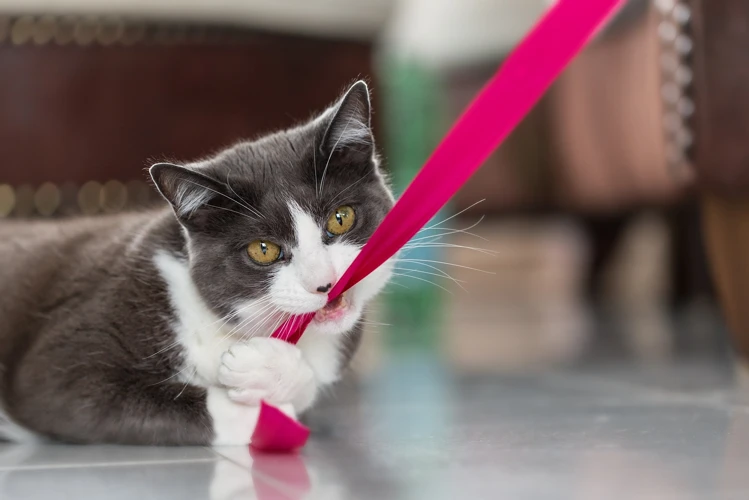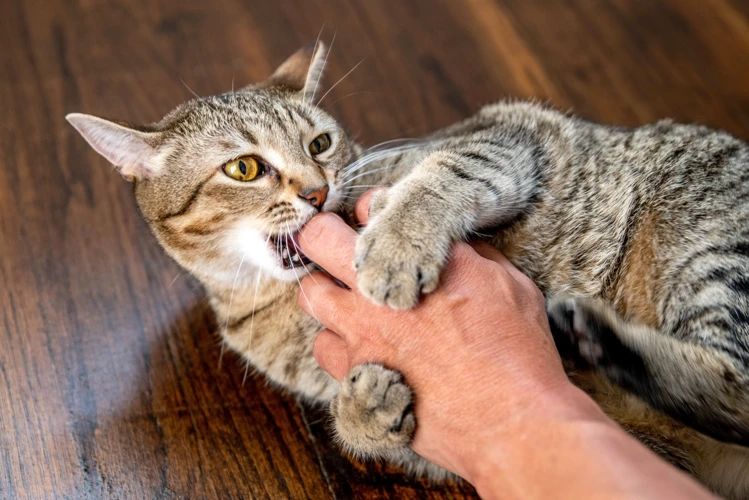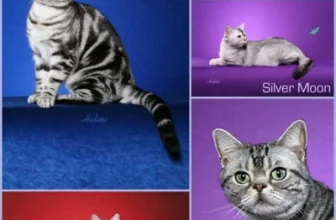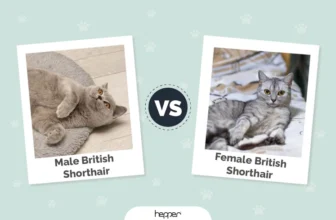Are you tired of playing with your American Shorthair only to end up with scratches and bites? It’s not uncommon for cats to exhibit playful aggression, but it’s important to teach them appropriate behaviors during playtime. In this article, we’ll explore the causes and impact of biting and scratching behavior in American Shorthairs, as well as effective techniques for discouraging these behaviors. Additionally, we’ll provide training tips for addressing biting and scratching behavior in your cat. By following these steps, you can enjoy playtime with your American Shorthair without the pain and scratches.
Understanding Biting and Scratching Behavior in American Shorthairs

As a cat owner, you may encounter biting and scratching behavior from your American Shorthair during playtime. While playtime is a great way to bond with your pet, understanding the reasons behind this behavior is important in addressing it effectively. This will not only help you prevent injuries but also maintain a positive relationship with your feline friend. In this section, we will dive deeper into the causes and impact of biting and scratching behavior in American Shorthairs. By the end of this section, you will be equipped with the knowledge to curb this behavior. If you are interested in other behavior-related topics, follow these links: how to stop your American Shorthair from scratching furniture, how to stop your American Shorthair from begging for food, tips to discourage your American Shorthair from marking indoors, eliminating your American Shorthair’s jumping habit, how to stop your American Shorthair from excessive meowing and how to eliminate American Shorthair’s night crazies.
Causes of Biting and Scratching
Biting and scratching are common behaviors among American Shorthairs, but they can be problematic if they are excessive or directed at humans. It’s important to understand the underlying causes of these behaviors in order to effectively address them. Some potential causes of biting and scratching in American Shorthairs include:
- Playfulness: American Shorthairs are known for their playful and energetic nature, and sometimes biting and scratching can be a result of playfulness. However, it’s important to distinguish between playful behavior and aggressive behavior.
- Fear or anxiety: Sometimes, biting and scratching can be a result of fear or anxiety. If your cat is feeling stressed or overwhelmed, they may resort to biting and scratching as a way to defend themselves.
- Territoriality: American Shorthairs can be very territorial, and biting and scratching may be a way for them to assert their dominance over their space.
- Health problems: In some cases, biting and scratching may be a sign of an underlying health problem, such as fleas, allergies, or an injury.
It’s important to observe your American Shorthair’s behavior and try to determine the cause of their biting and scratching. Once you understand why they are exhibiting these behaviors, you can take steps to address the underlying issue and prevent further biting and scratching.
Impact of Biting and Scratching
Undesired biting and scratching behaviors can have negative impacts on both cats and their humans. Such behaviors can lead to physical harm, damaged possessions, and emotional distress. Let’s explore the various impacts of biting and scratching in detail.
| Impacts on Humans | Impacts on American Shorthairs |
|---|---|
|
|
As illustrated in the table above, biting and scratching behaviors can have significant negative impacts on both cats and their humans. Proper training and appropriate response to such behavior is important to ensure a happy and healthy relationship between cats and their owners.
Effective Techniques for Discouraging Biting and Scratching

As a proud American Shorthair owner, it’s important to encourage healthy playtime habits while discouraging biting and scratching behavior. This can be a perplexing challenge for many pet owners, but there are a variety of effective techniques that can help address these behaviors. In this section, we will explore a variety of methods for discouraging biting and scratching, including positive reinforcement, redirecting behavior with toys, interrupting behavior with loud noises, discouraging roughhousing, providing alternative forms of play, discouraging playful aggression, and enforcing playtime boundaries. These techniques, when used consistently and in combination with appropriate training, can help establish healthy playtime habits and discourage negative behaviors.
Positive Reinforcement
Positive reinforcement is a highly effective technique for teaching your American Shorthair not to bite or scratch during playtime. This technique works by rewarding your cat when they exhibit good behavior, such as playing gently or not biting or scratching. Here are some examples of positive reinforcement techniques that you can use during playtime:
| Technique | Explanation |
|---|---|
| Using treats | Give your cat treats when they exhibit good playtime behavior. For example, when your cat plays gently or refrains from biting or scratching during playtime, give them a treat or two. This will encourage your cat to continue exhibiting good behavior. |
| Using praise | When your cat behaves appropriately during playtime, praise them with loving words and petting. Tell your cat that they are a good kitty and that you love them. This will make your cat feel happy and loved, encouraging them to continue exhibiting good behavior. |
| Using toys | Give your cat toys that are safe for them to bite and scratch during playtime. When your cat plays nicely with their toys, offer positive feedback by praising and petting them. This will teach your cat that playtime is for playing with toys, not biting or scratching people. |
Remember to always use positive reinforcement techniques consistently during playtime. Your American Shorthair will respond best to consistent positive feedback, which will encourage them to continue playing nicely and avoid aggressive behavior. Over time, with consistent use of positive reinforcement techniques, you’ll see a significant improvement in your cat’s playtime behavior.
Redirecting Behavior with Toys
When your American Shorthair starts to bite or scratch during playtime, it may be tempting to scold them or take away their toys. However, this approach can actually make the behavior worse. Instead, try redirecting their energy towards appropriate toys that they can scratch and bite without harming anyone or anything. Here are some toys that work well for redirecting your cat’s behavior:
- Scratching Posts: Providing your cat with a high-quality scratching post is one of the most effective ways to redirect their scratching behavior. Make sure the post is tall enough for them to fully stretch out, and place it in a prominent location.
- Interactive Toys: Toys that require your cat to engage with them, such as puzzle feeders or toys on a string, can redirect their biting and scratching behavior in a positive way.
- Soft Toys: Soft toys filled with catnip or other enticing scents can be a great way to redirect your cat’s energy towards something they can bite and kick without hurting anyone or anything.
When introducing new toys to your American Shorthair, be patient and don’t force them to engage with the toy. Allow them to approach and investigate the toy on their own terms. Once they start playing with the toy, reward them with treats and praise. Over time, you can use these toys as a way to redirect your cat’s biting and scratching behavior during playtime.
Interrupting Behavior with Loud Noises
One effective technique for discouraging biting and scratching behavior in American Shorthairs during playtime is interrupting the behavior with loud noises. This strategy aims to startle the cat, so they stop their undesirable actions immediately.
How to use loud noises to interrupt biting and scratching behavior?
The goal is to make a sudden, loud noise to surprise the cat and distract it from the undesirable behavior. Here are some steps to follow:
| Step 1: | Observe your cat during playtime and notice if they start to bite or scratch. |
| Step 2: | When the behavior starts, make a loud noise that will get your cat’s attention. You can use a whistle, clap your hands, or make a sudden, sharp sound with your voice. |
| Step 3: | The noise should startle the cat and stop it from continuing the unwanted behavior. |
| Step 4: | Immediately after the noise, distract your cat with a toy or treat and redirect them to a more appropriate playtime activity. |
It’s essential to understand that this technique is not meant to scare or harm the cat. It should create a sudden and surprising interruption, so they stop their behavior.
When to use loud noises to interrupt biting and scratching behavior?
Interrupting biting and scratching behavior with loud noises is most effective when the behavior is happening during playtime. It’s crucial to intervene immediately when the cat starts their undesirable actions. Also, it’s important to be consistent with this technique to reinforce that biting and scratching are not acceptable behaviors during playtime.
Using loud noises to interrupt biting and scratching behavior during playtime can be an effective deterrent strategy for American Shorthairs. It aims to redirect the cat’s attention to a more appropriate activity and create an association that biting and scratching during playtime will lead to a sudden and startling interruption.
Discouraging Playtime Roughhousing
Engaging in rough play with your American Shorthair may seem like a fun way to bond, but it can actually encourage aggressive behavior. Here are some techniques to discourage playtime roughhousing:
| Technique | Description |
| Redirecting | If your cat begins to engage in rough play, redirect their attention to a toy or object that they can safely play with instead. |
| Time-outs | If redirection doesn’t work and your cat continues to be too rough, remove them from the room or play area for a brief period of time as a consequence for their behavior. |
| Consistent reinforcement | Be consistent in your response to rough play. If you allow it one day and then discourage it the next, your cat will become confused and the behavior may continue. |
| Hygiene and grooming | It’s important to keep your cat’s claws trimmed and their living area clean to decrease the chance of injury during playtime. |
Remember, playtime is an important part of your cat’s daily routine, but it’s important to discourage rough play while still providing stimulating and enjoyable play experiences. By consistently discouraging roughhousing and redirecting your cat’s behavior, you can help them learn appropriate boundaries and decrease the likelihood of biting and scratching during playtime.
Providing Alternative Forms of Play
Cats love to play, and it is essential to provide them with alternative forms of play to redirect their natural instincts away from biting and scratching. Introducing new and exciting toys will encourage your American Shorthair to engage in safe and non-aggressive playtime activities.
One great alternative is to offer your cat interactive toys, such as crinkle balls, puzzle feeders, or feather wands. These types of toys will stimulate their natural hunting instincts and help them burn off excess energy. Additionally, interactive toys will encourage your cat to engage with you in playtime, which will help to strengthen the bond between you two.
Another alternative is to offer your cat scratching posts or boards. If your cat is prone to scratching furniture or other household items, providing them with a designated scratching area will help to redirect that behavior onto a more appropriate surface. You can also try sprinkling catnip on the scratching post to encourage your cat to use it.
If your American Shorthair prefers solo play, consider offering them puzzle toys. These toys will help keep your cat entertained for extended periods while also exercising their minds. Puzzle toys are available in many varieties and are designed to challenge your cat’s problem-solving skills.
Lastly, consider offering your cat a window seat or a perch where they can observe outdoor space. Watching birds or other wildlife outside can provide hours of entertainment for your cat and help them burn off excess energy.
Providing alternative forms of play is an effective way to encourage your American Shorthair to engage in non-aggressive playtime activities. By offering various toys and activities, you are providing your cat with stimulating and enriched experiences that will keep them happy and healthy.
Discouraging Playful Aggression
Playful aggression is a common behavior in American Shorthairs during playtime. However, it can quickly turn into biting and scratching if not addressed promptly. As an owner, it is important to discourage playful aggression to prevent harm to yourself and others.
Here are some techniques to discourage playful aggression in American Shorthairs:
| Technique | Description |
|---|---|
| Interrupt playtime when biting and scratching occur | When your American Shorthair bites or scratches during playtime, interrupt the playtime immediately. This sends a clear message that aggressive behavior is not acceptable during playtime. |
| Use a firm tone of voice | When your American Shorthair displays playful aggression during playtime, use a firm tone of voice to indicate disapproval. This sends a clear message that the behavior is not acceptable. |
| Provide timeouts | If your American Shorthair continues to display aggressive behavior during playtime, provide a timeout. This involves removing the cat from the play area and ignoring them for a period of time. This teaches the cat that aggressive behavior results in a loss of playtime. |
| Provide alternative outlets for energy | Provide your American Shorthair with toys and activities that offer alternative outlets for their energy. This can include cat trees, scratching posts, and puzzle toys. By offering multiple outlets for energy, you reduce the opportunity for aggressive behavior during playtime. |
By discouraging playful aggression, you can prevent harm to yourself and others. Using these techniques consistently can help correct the behavior and create a happy and safe playtime environment for both you and your American Shorthair.
Enforcing Playtime Boundaries
When it comes to playtime with your American Shorthair, it’s important to enforce boundaries that will discourage biting and scratching behavior. Here are some effective ways to do that:
- Establish Playtime Rules: Before every play session, make sure to establish clear rules about what types of play are acceptable and what are not. This could include not allowing your cat to play with your hands or feet, and only using designated toys for playtime.
- Set Time Limits: American Shorthairs are energetic and playful, but they also need rest and downtime. Make sure to set time limits for playtime to prevent overstimulation, which can lead to biting and scratching.
- Watch for Warning Signs: Pay close attention to your cat’s body language during playtime. If you notice flattening ears, dilated pupils, or an arched back, it may be a sign that your cat is becoming too agitated and needs a break.
- End Playtime on a Positive Note: To avoid sudden stops that can trigger biting and scratching, end playtime by gradually slowing down the pace of play and offering your cat a treat or a calm petting session as a reward.
By enforcing playtime boundaries, you’ll be able to help your American Shorthair feel more secure and less likely to engage in aggressive play behavior.
Training Tips for Addressing Biting and Scratching Behavior
Training is a crucial aspect of addressing biting and scratching behavior in American Shorthairs. By implementing the right techniques and providing consistent reinforcement, pet owners can help their cats learn more appropriate play behavior. In this section, we’ll take a closer look at some training tips that can help you effectively eliminate unwanted biting and scratching behavior in your American Shorthair. From starting training early to using positive reinforcement, these tips will provide you with the tools you need to effectively train your furry companion.
Starting Training Early
Starting Training Early: One of the most important things to keep in mind when trying to teach your American Shorthair not to bite or scratch during playtime is to start their training early. As soon as you bring your kitten home, you should begin to establish boundaries and rules for playing. By doing so, you can help prevent aggressive behavior from becoming a habit.
Here are some ways to start training early:
| Technique | Description |
|---|---|
| Setting Boundaries | Set boundaries for when and where playtime is allowed. For example, you can establish certain toys as playtime toys and only bring them out during designated playtime. This helps your American Shorthair differentiate between playtime and non-playtime. |
| Consistency | Be consistent in your training. If you tell your American Shorthair not to bite or scratch during playtime, be sure to enforce that rule every time. Inconsistency may confuse your kitten and make it harder for them to understand what behavior is expected of them. |
| Positive Reinforcement | Reward your American Shorthair for good behavior during playtime. This can be as simple as giving them a treat or a gentle pat on the head when they play nicely with their toys instead of biting or scratching. |
By starting your American Shorthair’s training early and being consistent in your efforts, you can help them understand what behavior is expected of them during playtime. Remember to give plenty of positive reinforcement when they exhibit good behavior and to set clear boundaries for playtime. With patience and a little bit of effort, you can teach your American Shorthair not to bite or scratch during playtime.
Being Consistent with Training
Consistency in training is key when it comes to teaching your American Shorthair not to bite or scratch during playtime. Consistency involves using the same commands and techniques every time your cat engages in the unwanted behavior.
To be consistent in training, create a list of commands and techniques that you will use, and stick to them. You can write these down as bullet points or create a checklist. This will help you remember what to do each time the behavior occurs.
Another way to be consistent is to train your cat regularly. Set aside a specific time every day to train your cat, even if it’s just for a few minutes. This will help your cat learn what is expected of them during playtime, and make it easier for them to understand and follow your commands.
It’s also important to stay consistent in your reactions to your cat’s behavior. If your cat bites or scratches, respond in the same way every time. This could involve redirecting their attention to a toy or making a loud noise to interrupt their behavior.
By being consistent in your training, you’ll help your American Shorthair understand what is expected of them during playtime and reduce their biting and scratching behavior.
Using Treats as Positive Reinforcement
Positive reinforcement is an effective technique for addressing biting and scratching behavior in American Shorthairs. Using treats as positive reinforcement is a great way to encourage good behavior and discourage bad behavior. When your American Shorthair behaves appropriately during playtime, give them a treat to reinforce that behavior. This positively reinforces the behavior, increasing the likelihood that your cat will repeat it in the future.
Here are some tips for using treats as positive reinforcement:
- Choose treats that your American Shorthair really likes. This will help motivate them to behave appropriately during playtime.
- Only give a treat when your cat has exhibited good behavior during playtime. Avoid giving treats for bad behavior, as this can reinforce the wrong behavior.
- Make sure to give treats immediately after your American Shorthair performs the desired behavior. This will help them connect the treat with the behavior.
- Consider using small, low-calorie treats to avoid overfeeding your cat.
- Be consistent with treat giving. This will help reinforce good behavior and encourage your cat to continue behaving appropriately during playtime.
Remember, positive reinforcement is just one technique for addressing biting and scratching behavior in your American Shorthair. Using a combination of techniques, such as redirecting behavior with toys and discouraging roughhousing, can also be effective. With patience and consistency, you can train your cat to play without biting or scratching.
Responding Appropriately to Biting and Scratching Behavior
When teaching your American Shorthair not to bite or scratch during playtime, it is important to respond to their behavior appropriately. Here are some tips on how to respond effectively:
- Stay calm: It can be easy to get frustrated or angry when your cat bites or scratches you, but it’s important to stay calm. Reacting with aggression or anger will only escalate the situation and could harm your relationship with your cat.
- Redirect their behavior: If your cat starts to bite or scratch you during playtime, redirect their behavior by tossing a toy for them to chase or play with. This will help them understand what behaviors are acceptable during playtime.
- Use a firm voice: If your cat continues to bite or scratch despite your redirection, use a firm, low voice to say “no” or “stop.” Avoid yelling or hitting your cat, as this will only damage your relationship and could lead to fear and anxiety.
- Ignore the behavior: In some cases, your cat may be biting or scratching you for attention. If this is the case, simply ignore the behavior and avoid reacting. Eventually, your cat will learn that biting and scratching do not result in attention.
- Provide timeouts: If your cat continues to bite or scratch even after redirection and vocal commands, provide them with a timeout in a quiet room or in their crate. This will help them understand that biting and scratching will result in playtime ending.
Remember, it’s important to respond to biting and scratching behavior in a way that is firm but not aggressive. Overreacting could lead to fear and anxiety in your cat, while ignoring the behavior or reacting inconsistently could lead to confusion. Consistent, calm responses will help your American Shorthair understand the appropriate way to behave during playtime.
Conclusion
After reading this article, you should have a better understanding of how to teach your American Shorthair not to bite or scratch during playtime. While it’s common for cats to exhibit this behavior when playing, it can become a problem if they don’t learn to control themselves.
By using the effective techniques for discouraging biting and scratching, such as positive reinforcement, redirecting behavior with toys, interrupting behavior with loud noises, discouraging roughhousing, providing alternative forms of play, discouraging playful aggression, and enforcing playtime boundaries, you can help your kitty learn appropriate behavior during playtime.
It’s also important to remember to start training early, be consistent with training, use treats as positive reinforcement, and respond appropriately to biting and scratching behavior. With patience and persistence, you can teach your American Shorthair to enjoy playtime without causing harm to you or themselves.
Remember to always monitor your cat’s behavior during playtime and intervene if necessary. By following these tips and techniques, you and your American Shorthair can have a safe and enjoyable playtime experience together.
Frequently Asked Questions
1. Can American Shorthairs be trained not to bite and scratch during playtime?
Yes, American Shorthairs can be trained not to bite and scratch during playtime. It requires consistent training and positive reinforcement techniques.
2. Why do American Shorthairs tend to bite and scratch during playtime?
American Shorthairs may bite and scratch during playtime out of excitement, frustration, or playful aggression. It’s important to understand the underlying causes to effectively address the behavior.
3. Are there any negative consequences of allowing my American Shorthair to bite and scratch during playtime?
Yes, allowing your American Shorthair to bite and scratch during playtime can lead to injury to both humans and other pets, as well as reinforcing negative behavior patterns.
4. Can redirecting behavior with toys be an effective technique for discouraging biting and scratching?
Yes, redirecting behavior with toys can be an effective technique for discouraging biting and scratching. Providing appropriate toys for your American Shorthair to play with can redirect their energy and help them learn appropriate play behavior.
5. What are some examples of loud noises that can be used to interrupt biting and scratching behavior?
Examples of loud noises that can be used to interrupt biting and scratching behavior include clapping, using a whistle, or using a spray bottle filled with water.
6. Is roughhousing during playtime a common trigger for American Shorthairs to bite and scratch?
Yes, roughhousing during playtime can be a common trigger for American Shorthairs to bite and scratch. Discouraging this type of behavior can help address biting and scratching during playtime.
7. Are there alternative forms of play that can help discourage biting and scratching during playtime?
Yes, providing alternative forms of play, such as puzzle toys and interactive play with their humans, can help discourage biting and scratching during playtime.
8. Can consistent training help address and discourage biting and scratching behavior in American Shorthairs?
Yes, consistent training can help address and discourage biting and scratching behavior in American Shorthairs. It’s important to start training early and use positive reinforcement techniques consistently.
9. Can treats be used as a positive reinforcement technique for discouraging biting and scratching behavior?
Yes, treats can be used as a positive reinforcement technique for discouraging biting and scratching behavior. It’s important to use them appropriately and in conjunction with other positive reinforcement techniques.
10. How should I respond to biting and scratching behavior during playtime?
It’s important to respond appropriately to biting and scratching behavior during playtime by interrupting the behavior, redirecting their energy with toys or alternative forms of play, and using positive reinforcement techniques. Avoid responding with physical punishment or aggression, as this can reinforce negative behavior patterns.







